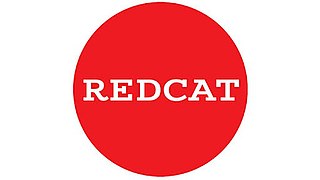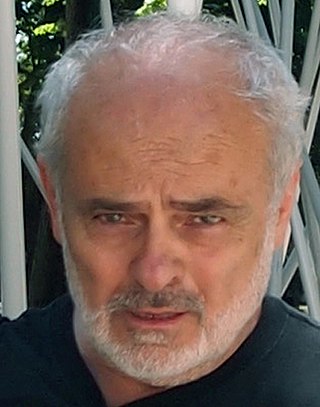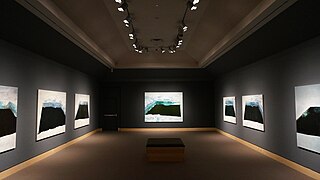Aesthetics is the branch of philosophy concerned with the nature of beauty and the nature of taste; and functions as the philosophy of art. Aesthetics examines the philosophy of aesthetic value, which is determined by critical judgements of artistic taste; thus, the function of aesthetics is the "critical reflection on art, culture and nature".

Frank Owen Gehry is a Canadian-born American architect and designer. A number of his buildings, including his private residence in Santa Monica, California, have become world-renowned attractions.

Postmodern art is a body of art movements that sought to contradict some aspects of modernism or some aspects that emerged or developed in its aftermath. In general, movements such as intermedia, installation art, conceptual art and multimedia, particularly involving video are described as postmodern.
Uta Barth is a contemporary German-American photographer whose work addresses themes such as perception, optical illusion and non-place. Her early work emerged in the late 1980s and 1990s, "inverting the notion of background and foreground" in photography and bringing awareness to a viewer's attention to visual information with in the photographic frame. Her work is as much about vision and perception as it is about the failure to see, the faith humans place in the mechanics of perception, and the precarious nature of perceptual habits. Barth's says this about her art practice: “The question for me always is how can I make you aware of your own looking, instead of losing your attention to thoughts about what it is that you are looking at." She has been honored with two National Endowments of the Arts fellowships, was a recipient of the John Simon Guggenheim Fellowship in 2004‑05, and was a 2012 MacArthur Fellow. Barth lives and works in Los Angeles, California.
Rosalind Epstein Krauss is an American art critic, art theorist and a professor at Columbia University in New York City. Krauss is known for her scholarship in 20th-century painting, sculpture and photography. As a critic and theorist she has published steadily since 1965 in Artforum,Art International and Art in America. She was associate editor of Artforum from 1971 to 1974 and has been editor of October, a journal of contemporary arts criticism and theory that she co-founded in 1976.

Roy and Edna Disney CalArts Theater (REDCAT) is an interdisciplinary contemporary arts center for innovative visual, performing and media arts in downtown Los Angeles, California, located inside the Walt Disney Concert Hall complex. Named for Roy O. Disney and his wife, it was opened in November 2003 as an extension of the California Institute of the Arts' mission into downtown Los Angeles.

Deconstructivism is a postmodern architectural movement which appeared in the 1980s. It gives the impression of the fragmentation of the constructed building, commonly characterised by an absence of obvious harmony, continuity, or symmetry. Its name is a portmanteau of Constructivism and "Deconstruction", a form of semiotic analysis developed by the French philosopher Jacques Derrida. Architects whose work is often described as deconstructivist include Zaha Hadid, Peter Eisenman, Frank Gehry, Rem Koolhaas, Daniel Libeskind, Bernard Tschumi, and Coop Himmelb(l)au.

Peter Halley is an American artist and a central figure in the Neo-Conceptualist movement of the 1980s. Known for his Day-Glo geometric paintings, Halley is also a writer, the former publisher of index Magazine, and a teacher; he served as director of graduate studies in painting and printmaking at the Yale University School of Art from 2002 to 2011. Halley lives and works in New York City.
Terry Smith is an Australian art historian, art critic and artist who currently lives and works in Pittsburgh, New York and Sydney.

Joshua Neustein is a contemporary visual artist who lives and works in New York City. He is known for his Conceptual Art, environmental installations, Land Art, Postminimalist torn paper works, epistemic abstraction, deconstructed canvas works, and large-scale map paintings.

Bracha Lichtenberg Ettinger is an Israeli born artist, writer, psychoanalyst and philosopher, living and working in Paris. She is a feminist theorist and artist in contemporary New European Painting who invented the concept of the Matrixial Gaze and related concepts around trauma, aesthetics and ethics. Ettinger is a professor at European Graduate School in Saas-Fee, Switzerland and at GCAS, Dublin. In 2023, she was part of the Finding Committee for the Artistic Director of Documenta’s 2027 edition. She resigned from that role with a public letter intended to open a radical discussion in the artworld, following the administration's rejection of her request for a pause due to the Israel-Hamas War.
Pattern and Decoration was a United States art movement from the mid-1970s to the early 1980s. The movement has sometimes been referred to as "P&D" or as The New Decorativeness. The movement was championed by the gallery owner Holly Solomon. The movement was the subject of a retrospective exhibition at the Hudson River Museum in 2008.

Eric Aho is an American painter living in Vermont. DC Moore Gallery in New York City represents his work.
Robert Kushner(; born 1949, Pasadena, CA) is an American contemporary painter who is known especially for his involvement in Pattern and Decoration. He has been called "a founder" of that artistic movement. In addition to painting, Kushner creates installations in a variety of mediums, from large-scale public mosaics to delicate paintings on antique book pages.
David Blackburn MBE was a British artist based in the north of England. He worked almost exclusively in the pastel medium and was noted for his highly evocative depictions of the landscape.
Amy Goldin was an American art critic who worked from 1965 until 1978. In those thirteen years, she published almost 200 pieces, from single paragraph reviews of current exhibitions, catalog essays, and book reviews. She covered topics that were unconventional at the time: Folk art, African-American art, craft, decoration, graffiti and Islamic art. Her writing appeared regularly in Arts, ARTnews, Artforum, Art Journal, New American Review, International Journal for Aesthetics and Art Criticism, and most frequently in Art in America, where she was a contributing editor.
James Hayward is a contemporary abstract painter who lives and works in Moorpark, California. Hayward's paintings are usually divided in two bodies of work: flat paintings (1975-1984) and thick paintings. He works in series, some of which are ongoing, and include The Annunciations, The Stations of the Cross, the Red Maps, Fire Paintings, Smoke Paintings, Sacred and Profane and Nothing's Perfect series.

Denzil Forrester is a Grenada-born artist who moved to England as a child in 1967. Previously based in London, where he was a lecturer at Morley College, he moved to Truro, Cornwall, in 2016.
In semiotics, a parergon is a supplementary issue or embellishment.









